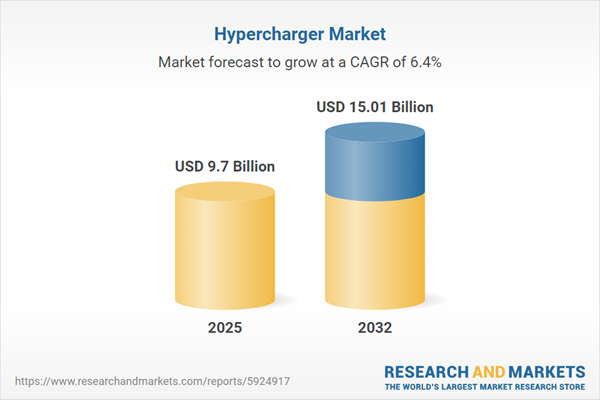Speak directly to the analyst to clarify any post sales queries you may have.
The hypercharger market is experiencing significant evolution, driven by increased electric vehicle adoption and changing regulations worldwide. Forward-looking decision-makers are revisiting infrastructure strategies and technology priorities to remain responsive as the competitive landscape shifts toward integrated, future-ready electric mobility solutions.
Market Snapshot: Hypercharger Market Size, Growth Trends, and Forecast
The global hypercharger market is projected to expand from USD 9.12 billion in 2024 to USD 9.70 billion in 2025, reaching USD 15.01 billion by 2032. This growth reflects a 6.41% compound annual growth rate (CAGR) over the forecast period. Market momentum is shaped by surging demand for fast and resilient electric vehicle charging infrastructure, an accelerating pace of digital innovation, and collaboration among industry participants. Shifting regulatory frameworks, growing sustainability expectations, and investments in advanced technologies are creating both opportunities and challenges, compelling organizations to continuously adapt their approach and sustain competitive differentiation across multiple geographies.
Scope & Segmentation: Hypercharger Market Coverage
- Application: Addresses diverse needs across commercial fleet charging operations, public charging hubs, residential communities, and retail locations. Hyperchargers are designed to ensure high speed, maximize uptime, and support elevated throughput that meets the operational demands of these varied environments.
- Power Output: Comprises charging units below 120kW for urban and city centers, 120–300kW units optimized for strategic transit corridors and moderate-traffic venues, and high-capacity solutions exceeding 300kW aimed at heavy-duty vehicles and logistics infrastructure.
- Connector Type: Ensures multi-brand compatibility through support for CCS, ChaDeMO, and Tesla connectors, thus enabling flexibility and readiness as vehicle technologies continue to advance.
- Vehicle Category: Caters to both passenger cars and commercial vehicle fleets, allowing organizations to scale their charging capabilities in line with dynamic mobility requirements and advances in fleet electrification.
- Installation Setting: Adapts to diverse placements, including structured indoor parking, open-air logistics parks, and complex public access locations, broadening overall market coverage and improving accessibility.
- Charging Mode: Supports both plug-in and wireless charging systems, accommodating various user preferences and providing resilience against evolving technology standards and adoption patterns.
- Regional Coverage: Responds to regulatory, consumer, and economic specificities across the Americas, Europe, Middle East & Africa, and Asia-Pacific—each region brings unique challenges and opportunities, from incentive structures to urban planning integration.
- Company Analysis: Features leading firms such as ChargePoint, Tesla, ABB, Siemens, EVBox, Schneider Electric, Delta Electronics, Tritium, Alpitronic, and Fastned. These organizations set standards for product differentiation, innovation, and agility through partnerships, targeted investments, and regionally adaptive growth strategies.
Key Takeaways: Strategic Insights for Hypercharger Market Leadership
- Investment in next-generation charging management platforms allows organizations to boost asset utilization and system uptime, ensuring scalable operations as infrastructure demands rise and network management becomes increasingly complex.
- Collaboration across utility providers, automakers, and technology stakeholders enhances the rapid rollout of high-performance infrastructure and encourages broad network interoperability to support mobility trends.
- Dynamic investment in both digital and hardware assets positions leaders to address shifting regulations quickly while remaining ready for advances in charging technology and standards.
- Mergers, targeted acquisitions, and strategic partnerships accelerate the integration of new technologies and reinforce operational continuity in a swiftly changing environment.
- Adopting analytics-driven systems equips operators with the capability to identify inefficiencies, fine-tune resource allocation, and strengthen operational transparency across extensive asset portfolios.
- Project strategies that reflect regional policies and incentives add deployment value and help organizations navigate the complexities of cross-regional operations.
Tariff Impact: Navigating U.S. Regulatory Adjustments in the Hypercharger Market
Recent modifications to U.S. tariffs on hypercharger components are prompting companies to reconsider their sourcing and supply chain planning. By prioritizing domestic procurement, organizations can minimize vulnerability to international cost fluctuations and capitalize on available local incentives. This adaptive approach improves resilience and facilitates compliance as regulatory changes continue to unfold in the U.S. hypercharger sector.
Methodology & Data Sources
This research is grounded in a rigorous approach involving qualitative interviews with industry leaders, targeted end-user surveys, site-level audits, and deep analysis of public financial disclosures and technical documents. Up-to-date market datasets supplement primary findings, ensuring reliable and actionable intelligence for stakeholders across the sector.
Why This Report Matters: Actionable Intelligence for Senior Decision-Makers
- Offers senior leaders strategic insight to optimize capital allocation, pursue effective market expansion, and manage risks in a rapidly evolving electric vehicle infrastructure ecosystem.
- Enables timely organizational response to evolving government policies and advances in business models that impact both local and international hypercharger markets.
- Equips established and emerging players with guidance to identify new business opportunities, leverage partnerships, and adapt for continued success in the expanding hypercharger landscape.
Conclusion: Gaining an Edge in the Hypercharger Ecosystem
Organizations that align operational agility with deep regulatory awareness and consistently drive efficiency will be well-positioned for sustainable growth. This report provides the essential intelligence needed to navigate complexity and create advantage in a dynamic market.
Additional Product Information:
- Purchase of this report includes 1 year online access with quarterly updates.
- This report can be updated on request. Please contact our Customer Experience team using the Ask a Question widget on our website.
Table of Contents
3. Executive Summary
4. Market Overview
7. Cumulative Impact of Artificial Intelligence 2025
Companies Mentioned
The companies profiled in this Hypercharger market report include:- ChargePoint, Inc.
- Tesla, Inc.
- ABB Ltd.
- Siemens AG
- EVBox Group B.V.
- Schneider Electric SE
- Delta Electronics, Inc.
- Tritium Pty Ltd
- Alpitronic GmbH
- Fastned N.V.
Table Information
| Report Attribute | Details |
|---|---|
| No. of Pages | 180 |
| Published | November 2025 |
| Forecast Period | 2025 - 2032 |
| Estimated Market Value ( USD | $ 9.7 Billion |
| Forecasted Market Value ( USD | $ 15.01 Billion |
| Compound Annual Growth Rate | 6.4% |
| Regions Covered | Global |
| No. of Companies Mentioned | 11 |









